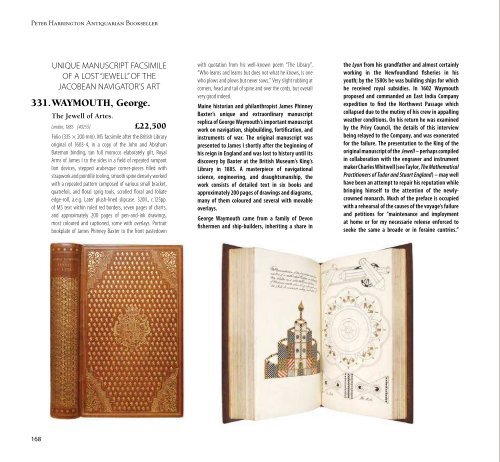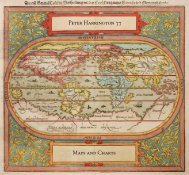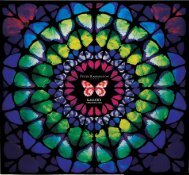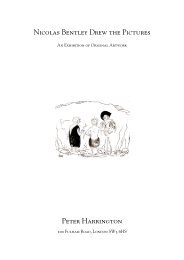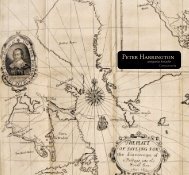antiquarian bookseller - Peter Harrington
antiquarian bookseller - Peter Harrington
antiquarian bookseller - Peter Harrington
You also want an ePaper? Increase the reach of your titles
YUMPU automatically turns print PDFs into web optimized ePapers that Google loves.
<strong>Peter</strong> <strong>Harrington</strong> Antiquarian Bookseller<br />
168<br />
UNIQUE MANUSCRIPT FACSIMILE<br />
OF A LOST “JEWELL” OF THE<br />
JACOBEAN NAVIGATOR’S ART<br />
331.WAYMOUTH, George.<br />
The Jewell of Artes.<br />
London, 1885 [40255] £22,500<br />
Folio (335 × 200 mm). MS facsimile after the British Library<br />
original of 1603-4, in a copy of the John and Abraham<br />
Bateman binding, tan full morocco elaborately gilt, Royal<br />
Arms of James I to the sides in a field of repeated rampant<br />
lion devices, stepped arabesque corner-pieces filled with<br />
strapwork and pointillé tooling, smooth spine densely worked<br />
with a repeated pattern composed of various small bracket,<br />
quatrefoil, and floral sprig tools, scrolled floral and foliate<br />
edge-roll, a.e.g. Later plush-lined slipcase. 320ll., c.125pp.<br />
of MS text within ruled red borders, seven pages of charts,<br />
and approximately 200 pages of pen-and-ink drawings,<br />
most coloured and captioned, some with overlays. Portrait<br />
bookplate of James Phinney Baxter to the front pastedown<br />
with quotation from his well-known poem “The Library”,<br />
“Who learns and learns but does not what he knows, Is one<br />
who plows and plows but never sows.” Very slight rubbing at<br />
corners, head and tail of spine and over the cords, but overall<br />
very good indeed.<br />
Maine historian and philanthropist James Phinney<br />
Baxter’s unique and extraordinary manuscript<br />
replica of George Waymouth’s important manuscript<br />
work on navigation, shipbuilding, fortification, and<br />
instruments of war. The original manuscript was<br />
presented to James I shortly after the beginning of<br />
his reign in England and was lost to history until its<br />
discovery by Baxter at the British Museum’s King’s<br />
Library in 1885. A masterpiece of navigational<br />
science, engineering, and draughtsmanship, the<br />
work consists of detailed text in six books and<br />
approximately 200 pages of drawings and diagrams,<br />
many of them coloured and several with movable<br />
overlays.<br />
George Waymouth came from a family of Devon<br />
fishermen and ship-builders, inheriting a share in<br />
the Lyon from his grandfather and almost certainly<br />
working in the Newfoundland fisheries in his<br />
youth; by the 1580s he was building ships for which<br />
he received royal subsidies. In 1602 Waymouth<br />
proposed and commanded an East India Company<br />
expedition to find the Northwest Passage which<br />
collapsed due to the mutiny of his crew in appalling<br />
weather conditions. On his return he was examined<br />
by the Privy Council, the details of this interview<br />
being relayed to the Company, and was exonerated<br />
for the failure. The presentation to the King of the<br />
original manuscript of the Jewell – perhaps compiled<br />
in collaboration with the engraver and instrument<br />
maker Charles Whitwell (see Taylor, The Mathematical<br />
Practitioners of Tudor and Stuart England) – may well<br />
have been an attempt to repair his reputation while<br />
bringing himself to the attention of the newlycrowned<br />
monarch. Much of the preface is occupied<br />
with a rehearsal of the causes of the voyage’s failure<br />
and petitions for “maintenance and imployment<br />
at home or for my necessarie releese enforced to<br />
seeke the same a broade or in foraine cuntries.”<br />
In the text he emphasizes “the explorercolonizer’s<br />
need for a knowledge of navigational<br />
instruments, shipbuilding, machinery, gunnery, and<br />
fortification” (ODNB). The six books contain a series<br />
of “demonstrations” of these sciences illustrated by<br />
elaborate diagrams. The most substantial section<br />
is that on “Diverse instruments for navigation”,<br />
including the cross-staff, the quadrant, the astrolabe<br />
and the compass, and techniques “for sea men<br />
to keepe there reckonings of there shippes way.”<br />
The second part is dedicated to “the manner of<br />
building of shipp[s] by A geometrical proportion…<br />
whereby any worke man of mean capacitie having<br />
some small skill in Arithmetick and geometrie” can<br />
avoid error and produce ships both “more offensive<br />
and defensive than those nowe used.” Waymouth’s<br />
“Engines”, include the use of inflated pig-skins to<br />
help soldiers swim over rivers; a turntable device<br />
edged with blades and mounted with “small<br />
murdering pieces which will carry some 40 or 50<br />
muskett bulletes” which can withstand assault and<br />
carry a lethal fire “in to any one, or diverse partes<br />
of the shipp where it is assaulted”, together with<br />
a primitive tank and gunboat for riverine warfare.<br />
A section on various forms of mensuration follows,<br />
how to measure the height of castle walls, the depth<br />
of a well and the “most necessarie Instruments<br />
to survey land with.” The “fifte booke concerning<br />
fortification” contains a series of plans for complex<br />
gun forts and castles, together with instructions on<br />
mining and counter-mining, clearly demonstrating<br />
Waymouth’s belief that the “the practise of<br />
fortification nowe as necessarilie be imployed in the<br />
land of Florida” as in Europe. The final part is on the<br />
manufacture of ordnance and gun-carriages, and<br />
the calculation of trajectories. In all a remarkable<br />
navigator-artificer’s vade mecum, the possibility<br />
of Whitwell’s contribution perhaps underscored by<br />
the reliance on various elaborate “instruments.”<br />
If Waymouth’s highly ingenious gift to the King did<br />
not obtain for him the direct Royal patronage that<br />
he was seeking, it may well have been instrumental<br />
in obtaining him command of another expedition.<br />
Catalogue 57: Travel Section 7: Mapping, Navigation and Naval History<br />
In 1605 he found “sponsors from the worlds of<br />
commerce and colonization: Plymouth merchants<br />
interested in the cod fishery; Sir Thomas Arundell,<br />
who wished to establish an American colony for<br />
Roman Catholics; and possibly Arundell’s brother-inlaw,<br />
the Earl of Southampton” (ODNB). Southampton<br />
had been Essex’s collaborator in the planned rising<br />
against Elizabeth, and on his accession James had<br />
freed him from imprisonment and recreated him as<br />
Earl. Perhaps James had shared the perusal of the<br />
manuscript with his ambitious favourite, who put his<br />
influence behind the mounting of the expedition. In<br />
March 1605 Waymouth set off in the Archangell on a<br />
voyage of exploration and possible colonization. It is<br />
for this exploit that he is primarily known, one of the<br />
earliest European expeditions to coastal Maine, which<br />
is recorded in James Rosier’s A True Relation of the<br />
Most Prosperous Voyage made this Present Yeere 1605<br />
by Captaine George Waymouth… (London, 1605). His<br />
true destination was probably the region between<br />
Chesapeake Bay and Cape Cod, but pushed further<br />
north by bad weather the expedition reached the<br />
George River in present-day Maine in mid-May. They<br />
remained a month in the Georges Islands, where they<br />
traded with the local Abenaki Indians, eventually<br />
capturing and bringing back four of them – together<br />
with the famous Squanto, a visiting Patuxet, who<br />
later served on John Smith’s 1614 voyage to Virginia<br />
– for future use as guides and interpreters. The<br />
expedition opened the way for the establishment of<br />
the short-lived but historically significant Plymouth<br />
Company Popham colony in Maine, founded in 1607.<br />
It was whilst seeking fresh materials on this subject<br />
in the King’s Library that Baxter was introduced,<br />
through serendipity and the hard work of an intrepid<br />
assistant librarian, to the previously misshelved<br />
manuscript of the Jewell: “I followed him and he<br />
took down a large manuscript volume elegantly<br />
bound and laid it before me, entitled Jewell of Artes<br />
by George Waymouth, which was a present by him<br />
to James First. ‘I do not know as this is any interest<br />
to you,’ said Kensington, ‘but as you instructed me<br />
to call your attention to anything possibly relating<br />
to your subjects I thought I would show it to you.’<br />
… I immediately procured an expert to copy<br />
and make facsimiles of the numerous drawings<br />
which the book contained, and the binder of the<br />
Museum had especial tools make that he might<br />
make for a facsimile binding of the original.” On<br />
his return to America Baxter made this replica<br />
available to Henry S. Burrage who was working<br />
on a new edition of Rosier’s account, leading to<br />
a rapid reassessment of Waymouth’s reputation,<br />
from that of “a competent English shipmaster<br />
only”, a “rough and uneducated adventurer”, to<br />
highly competent navigator at home in the worlds<br />
of artificer-scientists and aristocratic patronage.<br />
Waymouth considered the content of this work to be<br />
close to a state secret, stating in his preface – with<br />
perhaps a mingled sense of threat and promise<br />
– that he had withheld it from publication for fear<br />
that “foraine nations, for whome I nothing meant it<br />
should reape as much proffit of it as this my natiue<br />
countrie.” It is unsurprising therefore that the BM<br />
copy remained the only contemporary version<br />
known until 1971, when Henry C. Taylor bequeathed<br />
his library on navigation and the early exploration<br />
of America to the Beinecke. Amongst the collection<br />
was another early 17th-century copy, almost<br />
identical in content and binding to the BM’s, but<br />
unfortunately possessed of no earlier provenance<br />
than that of Taylor. The present manual facsimile<br />
is by all accounts a perfect replica of the British<br />
Museum copy with respect to its text, illustrations<br />
and binding. The only significant differences are<br />
that the text is executed in a neat and clearly legible<br />
Victorian hand rather than crabbed 17th-century<br />
script, and that no attempt was made to duplicate<br />
the original paper. The Jewell of Artes, in both its<br />
original undertaking and this unique manuscript<br />
reproduction, represents major historical moments<br />
of scholarship, craftsmanship, and discovery.<br />
Offered here in the only obtainable copy.<br />
169


